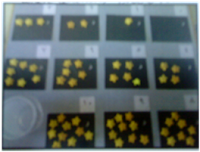 |
Colors Spinner |
Colors are very important for children. The child will move the hand of the clock and the hand will stop on one color. The child will choose a circle that has the same color of the circle third which the hand is located .For example, if the clock hand is pointing at the red third of the clock, the child should find a red circle and match it with the red circle in the laminated card.
To Download Files:
http://www.slideshare.net/magicalbawadi/final-report-7973741
http://www.slideshare.net/magicalbawadi/1-7973695
http://www.slideshare.net/magicalbawadi/ss-7973696
http://www.slideshare.net/magicalbawadi/final-report-7973741
http://www.slideshare.net/magicalbawadi/1-7973695
http://www.slideshare.net/magicalbawadi/ss-7973696
 |
| Let’s Touch |
Texture is a very common practice in children daily lives. This activity reinforces the sense of touch Only by using the sense of touch, children feel each board surface by one hand and find the card which has the same texture. They will match the same texture and identify the rough and smooth texture.
To Download Files:
http://www.slideshare.net/magicalbawadi/learning-task111
http://www.slideshare.net/magicalbawadi/ss-7973694
http://www.slideshare.net/magicalbawadi/ss-7973694
 |
| Land, Water, Air |
Children work independently to put the objects which they can be found in – land, water, and air- in their right places. The containers which represent the three environment systems – land, water, and air- can help children sort pictures correctly.
 |
Matching Colors. |
Children will work independently to arrange the laminated color cards and match to them the same color of the felt cards. They may name the pictures on the laminated cards.
Start with the primary colors and add the secondary colors with gold and silver according to the child's progress.
http://www.slideshare.net/magicalbawadi/ss-7973680
http://www.slideshare.net/magicalbawadi/ss-7973711
http://www.slideshare.net/magicalbawadi/ss-7973711
 |
| Plant parts puzzle |
Children work independently to put the plant parts in their right place on a felt board. Cutouts from "felt" materials are used to stick directly on the board that is covered with black felt. The child rearranges the parts until he can put each part in the correct place.
 |
where the animals live |
Students work independently to put the animals(which live in desert, sea, forest) in their right places on a felt in cartoon. Cutouts from “felt’’ materials are used to stick in the cartoon with glue. The student classifies the animals until he can put each animal in the correct place .
To Download Files:




















